#filipino monsters
Explore tagged Tumblr posts
Text
Okay, I should probably post the longer legend later, but I just read a lot about manananggals and aswangs in general lately and oh my goodness, there's a story that contains a manananggal baby!
The context is that two men stay over a family's house and some time in the night, they wake up to see the other family members rubbing a sort of oil or lotion on their arms which make them separate from their body and allow them to fly (something consistently established in most Luzon stories of manananggals as I've noticed). The family leaves behind their baby, sleeping peacefully as they went off to hunt presumably, leaving the two men alone with the child and the bottle of oily lotion.

I don't know really, it's just a little surprising to find that there is a story that at least contains this detail because most manananggal in modern media and even folk stories focus on just young women and often the only family being their sisters or their old mothers. I had never read about a manananggal baby before and especially in regards of a folk legend so this is a little delightful.
#filipinfodump#filipino#philippines#filipino monsters#filipino legends#tagalog legends#manananggal#mod maya
23 notes
·
View notes
Note
Can you tell us more about Filipino mythology and moneters, cause there's no 1 official website and I almost always barely passed filipino? Can you also list like great sources for me to read? Thanks
I had a pretty busy week last week so it took a while to get to this ask but I'd love to give more info on the topic!
More on Filipino Mythology:
Si Apolaki at Mayari - Bakit may araw at gabi
EN: Apolaki and Mayari - Why there's day and night
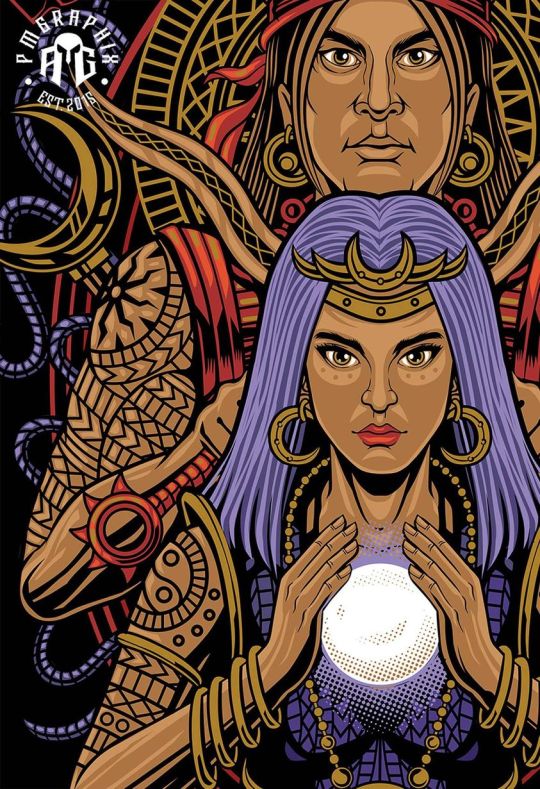
An illustration of Apolaki and Mayari created by the illustrator PM Graphix
I am currently still doing a write-up on the Tagalog pantheon so I could start by maybe talking about that and what I've found. For the mythology section of this, let me start with something that's actually not from the Tagalog pantheon but is often attributed to the Tagalog pantheon: the Kapampangan story of Apolaki and Mayari or why the day and night exist. This story has been sourced from Maximo D. Ramos's book Philippine Myths, Legends, and Folktales (which you can buy on Amazon here, sadly I cannot find a free version of the book without going through suspicious links) and posted by Jordan Clark of The Aswang Project on his website.
BATHALA, the creator of the world, had a son named Apolaki and a daughter named Mayari. The light that shone upon the world and enabled the people, the beasts, the birds, and the fish to see came from the bright eyes of Apolaki and Mayari, So all the creatures loved them dearly. Bathala himself was very fond of his children, and he watched over them as they wandered across the meadows of heaven. Since the eyes of Apolaki and Mayari shone continuously, it was always day on the earth. In time Bathala grew feeble with age and died. Then Apolaki and Mayari had a quarrel, for each wanted to rule the world alone. “I am the man and I will succeed my father to the throne,” said Apolaki. “I am going to rule the world, whether you like it or not.” Mayari’s eyes flashed with anger and she said, “I am no less my father’s child than you. I will succeed him to his throne, whether you like it or not!” The quarrel grew from bad to worse, and finally words could not express their furious rage. So they picked up wooden clubs and fell upon each other with fierce blows. Back and forth they fought until at last Apolaki struck Mayari in the face and she became blind in one eye. When he saw his sister stricken, Apolaki took pity on her and said, “Let us fight no more, my sister. Let us share our father’s kingdom equally between us. Let us reign by turns and be friends.” Mayari agreed, and from then on, Apolaki, whom we know today as the Sun, has ruled the world half the time. Mayari, whom we now know as the Moon, has taken turns with her brother in ruling the world. When Apolaki is on the throne, the world is flooded with warm light, because the light beams from his two bright eyes. On the other hand, when Mayari is reigning, the world is bathed with cool and gentle light; for she is blind in one eye.
Now from what I've researched, a lot of places tend to attribute the story to the Tagalog people or state that it is a shared story from both the Tagalogs and their neighboring Kapampangan up north from them but I cannot find any specific source prior to the late 1960s that even mention that Mayari was part of the Tagalog pantheon so it may be a more recent addition.
The source that first states Mayari's inclusion as a part of the Tagalog Bathala's court comes from a paper written by F. Landa Jocano called Notes on Philippine Divinities (1968) where he does not cite a specific source of where he has learned Mayari was of Tagalog origin nor even stated that he had learned it from a Tagalog local and considering Jocano himself isn't a Tagalog nor is he Kapampangan, it's unlikely he's learned it from his upbringing or otherwise.
I had also done a little digging on his sources and none of them bring up Mayari nor her sister Hanan, the goddess of dawn, so the paper leaves much room for doubt. Tala, the goddess of stars, who is also listed in Jocano's paper make a lot more sense despite the lack of sources as it is the actual word for star in Tagalog but I still have to do further research on her as well.
Either way, I had also never heard of Mayari as a Tagalog deity outside Jocano's work and online articles that heavily source Jocano (The Aswang Project, one of the most popular sources for Filipino mythology which I had used as a specific source for Kapampangang mythology, has cited him twice in regards to Tagalog mythology specifically but not Kapampangan mythology). This is also despite me being born and raised within a mostly Tagalog community.
All of that for me to say that this story of Apolaki and Mayari may be a later addition to the Tagalog mythos after interests on Filipino mythology got revitalized from the mid-20th century onward rather than something that has always been a part of the Tagalog mythology.
Note that I'm not saying that it is an impossibility that this had been part of the Tagalog culture prior to that time period, but a lot of sources that discuss this do not bring up this story until after Jocano's work. I will have to maybe do more reading on this to find out more information about this and Mayari's status on whether or not she did belong to the Tagalog pantheon prior to the 60s.
I also want to add a quick note that it's pretty common for people to misattribute this story to the Pangasinense people as well but it may be from both people constantly confusing Pampanga from Pangasinan (think of it as how people confuse Sweden and Switzerland), as well as a name overlap with Apolaki who is referred to as Apolaqui in Pangasinan. The two places are both north of the Tagalog Regions. I might look into this connection/association/coincidence later on.
Further Readings and Sources
It's actually pretty hard to suggest a specific source for Filipino mythology given that a lot of them pull from the same reference (Notes on Philippine Divinities) which I had said has some dubious information but Maximo D. Ramos's book that I had referenced is a good read as it collects various myths from different places throughout the country. I myself had been thinking of getting a copy of the book soon as well as his other books.
Some Filipino Monsters
As for Filipino monsters, I could say that its similar with Filipino mythology, in that with so many cultures, there's many different kinds on who you're asking. These ghouls seem to be more widely similar from culture to culture, however, probably owing to the fact that the Catholic Church didn't discourage the belief in them as much as they did the precolonial gods. Whether you go to the northernmost part of the country to the southernmost islands, there is a lot of similarities between the creatures that they could be classified easier than the gods with some creatures even sharing traits from cryptids from other Southeast Asian countries.
I'll give some of them here that you may hear pretty often when looking through catalogues of Filipino monsters. I have to be honest that I may not source as much for this section since I will be bringing up some personal stories and anecdotes that are passed around the community. I'm also open to discuss more about these creatures as well as other monsters later on.
The Aswang
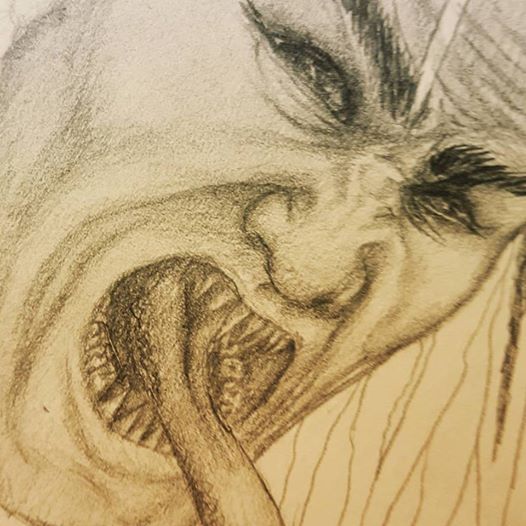
An artwork of an aswang uploaded to Wikipedia by H.M.Bec
Aswangs are often considered as the most ubiquitous of the Filipino monsters. When you look up monsters from the Philippines, this may be the top result. Aswangs are often portrayed as people who transform into ghoulish creatures that feast on human flesh but especially children, babies, and fetuses. There's so many stories and variations of aswangs, however, that some of the monsters in this list are actually sometimes considered as part of the aswang category depending on the source or who you ask.
Aswangs are shapeshifters, often turning into dogs, pigs, and many other creatures, in order to stalk their prey in the middle of the night.
Aswangs are also considered as one of the main stock monsters in FIlipino media so you may see them as the villains of a lot of fantasy series and movies. They're one of the villains that Alexandra Trese faces of regularly on the folklore-inspired supernatural comic book series turned Netflix original animation Trese. They're also the main antagonist in my favorite FIlipino fantaserye series Juan De La Cruz (although I don't particularly like the lead actor anymore lol).
Here's some stuff I've heard about Aswangs from those around me.
Aswangs often won't attack their neighbors and would rather attack neighboring villages/barangays/towns. This is so they avoid detection or suspicion from their community. So, if you suspect your neighbor's an aswang, then you might just be lucky they won't target you.
Aswangs are often said to have come from the province of Capiz. It's an often common joke and stereotype that Capizeños may be aswangs themselves or know people who are aswangs. The people of Capiz are mixed on how they feel about the association with the provincial government seemingly trying to shake off the specific association to their province.
They can go to mass but cannot stay during the consecration of the holy host. Holy water and holy [coconut] oil also boil in their presence.
When you look directly into their eyes, your reflection would be upside-down. They also don't have the dent between the nose and the lips.
They could pass their curse through different ways and may depend on belief or tradition. One belief states that if a person marries an aswang, they also become an aswang.
One of the other beliefs that can turn a person into an aswang is if one makes contact with an aswang's saliva.
According to another belief, a person could also become an aswang if they ingest a black chick alive.
Similarly, an aswang cannot die until they pass their curse to another person (typically a relative). This is done by passing a black stone or chick hidden in their body to the chosen new curse holder.
They hate the typical ghoulish hated items like holy crosses, water, oils, and the classic garlic and salt, but they also hate calamansi (a small Filipino citrus fruit), and my mother had always told me that they hate suha or pomelo (a type of citrus fruit) and the smell of burning rubber.
A typical weapon used to fight against them or ward them off is the buntot pagi or stingray tail that is often sold in occultic shops around the country. You could also buy this from online stores as I've learned (x)(x)(x).
Now here's a story I've heard about them:
A story I had heard was that of the aswang bus. I had heard it repeatedly throughout the years but the basic premise is that there's a bus of a bunch of aswangs from a different province that's traveling to [province you are in] and are hunting down people at night. This is some of the more funny stories about aswangs because I keep imagining an aswang bus driver purposefully running over people and then a bunch of aswang tourists hops off of the bus to drag the body for a snack later.
I honestly might come back to the aswangs topic later since I had just learned some things from a Capizeña who works to help around our house.
The Manananggal

An artwork of an aswang uploaded to Wikipedia by Gian Bernal
The Manananggal is a ghoulish creature and is often times categorized as a kind of aswang. They are typically humanoid creatures that appear as regular people (often women) during the day, but at night their torso severs from their legs and fly away with bat wings. They often feast on fetuses using their long proboscis tongue.
These ghouls share a lot of similarities with the Southeast Asian ghoul called the Penanggal which is a similar creature but instead of their torsos separating, their heads separate from their body alongside their entrails.
Manananggals are also some of the typical stock monsters in Filipino fantasy stories. I can't think of any specific instances of the manananggal being the main character besides the softer depiction of a manananggal girl named Anna in Dayo: Sa Mundo ng Elementalia who acts as a deuteragonist to the human boy Niko. They are also featured in Trese where a tribe of manananggal is shown. They are also the main lead or love interest in some horror movies and even horror romances.
Here's some stuff I've heard about Manananggals
It's name comes from the Tagalog word "tanggal" which means "to remove" or "to separate" and specifically means "the remover" or "the separator". This of course is a reference to the fact that it removes its torso from its legs or separates its body in half.
Unlike the typical aswang which transform back during daylight, the manananggal needs to find their way back to their body or else die by sunlight.
The unattached legs of the manananggal is their weakness. If found by a person, they only need to sprinkle salt or smear crushed garlic on the legs in order to destroy them.
A lot of the typical things that ward off the aswang are also typically effective towards the manananggal.
Similarly to the aswang, manananggals are also said to had come from Capiz.
The list is shorter because honestly, just take what most you've heard about the aswang and apply it here. I don't know specifically if things like the upside-down reflection or the lack of the dent between the nose and lips could apply to manananggals, however, and I don't think I've heard people claiming that about the manananggal.
Now here's a story I've heard about them:
One story I heard that I find quite funny was something my sister heard from one of her high school friends. This friend was struggling to fall asleep at night and was tossing and turning in bed when she heard bat-like fluttering from outside. She went out to inspect the source by looking out the window and was shocked to see a manananggal climbing up a coconut tree and seemingly harvesting the fruit in the middle of the night. She wasn't flying up the tree, she was climbing it.
The next day, an old woman who was selling her goods door-to-door came by their house. She was selling coconuts.
The Tiyanak

A screenshot of a tiyanak from the movie Tiyanak (1988)
The tiyanak is considered as a demonic baby that would transform itself into a regular looking baby, crying in the middle of the night in order to attract their unfortunate target who may feel pity towards the child. The tiyanak may also be classified as an aswang but is typically considered as a separate thing more often than the manananggal from my experience. This creature has noticeably a lot in common with a lot of other Southeast Asian and East Asian myths about demonic babies and toddlers like the tuyol or the tuyul.
Like the previous two, the tiyanak is also part of the typical stock monster antagonists found in Filipino media, but not as much as either the typical aswang or the manananggal. They are often used to add a bit of a scare factor into a story and isn't typically the main antagonist of a story as of recent horror movies (with only a single short B-Movie I could think of called Flight 666 from the Shake, Rattle & Roll horror anthology series. It is not a good movie but it's stupid fun). They are featured, as usual, in Trese as the main supernatural antagonists of a specific story arc. Their depiction from the comic and the Nteflix show has been changed due to the controversial nature of the comic book depiction.
When they appear in a horror series, there's often a sort of reason or lesson as to why one has appeared and typically based on the typical origins of the tiyanak.
The most common belief is that the tiyanak is the ghost or ghoulish corpse that had come from an unbaptized child.
At times, they may be a ghoulish baby that had been created after a woman gets an abortion, other times it is simply just a baby that had died before baptism often as a stillbirth or even as a joint death with their mother.
I had also heard that it may be an abandoned baby that had died to the elements.
It is also believed, the reason that they are cursed to wander the earth after death is because they were not given a name through baptism.
Because of this, when they typically appear in stories, it is often either a story about the bad that could come from abortion or child abandonment depending on the values of the writer.
The tiyanak would also sometimes lead people astray with its cries.
Speaking of its cries, there are some places that believe if the cry sounds loud and near, the tiyanak is actually farther away from you than if you hear the cries to be quieter and farther.
Here's a story I had heard about them:
A common Filipino story of the tiyanak is the parking lot story. Story goes that in certain parking lots of buildings, typically malls, you may hear a baby cry in the middle of the night when you're alone. This is a tiyanak that's trying to lure you in by seemingly tricking you into thinking that it is just an innocent abandoned baby which is sadly common in the country. It is common enough that there are some people who would often want someone to accompany them when they're alone in a parking lot at night.
Further Readings and Sources
As much as I had stated that The Aswangs Project and their handling of discussions about Filipino mythology, specifically Tagalog mythology, is dubious at best, they have a lot of good articles about aswangs that do align with local beliefs so reading through their website for monsters specifically could be a good and free resource. They had also made a documentary that you can watch for free on YouTube that covers a lot of this and more about aswangs.
For written works, I would suggest any of Maximo D. Ramos's works as I've brought up before. There's his published paper The Aswang Syncrasy in Philippine Folklore which is considered as basically the holy grail of Aswang research, which, as I had stated, take up a bulk of the FIlipino monsters. It's hard to find easily accessible PDFs of the paper and I remember that I found a copy of this or a similar work by Ramos but the link has eluded me.
For a less academic and more fun fictionalized source for Filipino monsters I suggest The Lost Journal of Alejandro Pardo: Meet the Dark Creatures from Philippines Mythology by Budjette Tan and David Hontiveros which is available through Amazon here. It follows a fictional researcher and his discoveries of Filipino monsters and other creatures. It's a pretty easy read with a lot of good information about cryptids and monsters from the Philippines, owing to it's style of found media. If you've seen something like Gravity Falls's officially published Journal 3 from the show's universe, it has a similar vibe to that.
That's all I have for now, but I am looking more into this topic! My PC has issues right now so I might answer questions more slowly than my already slow answering speed. I hope this post helped you learn a little more about Filipino mythology and cryptids.
#mayaposts#mayaqna#mayapino#filipino mythology#kapampangan mythology#tagalog mythology#filipino folklore#filipino monsters#bathala#apolaki#mayari#aswang#manananggal#tiyanak#long post#very long post#philippines#filipino
45 notes
·
View notes
Text
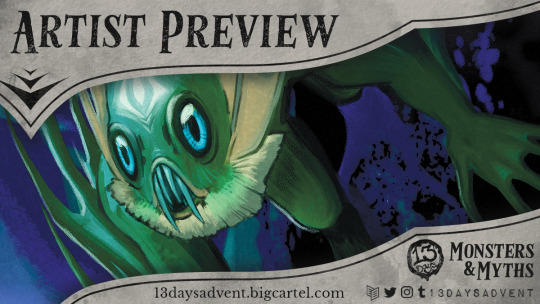
Out of the depths and into our zine, next up is @desansen 's piece featuring the Siyokoy! 🌊
Want to see the rest? Check out our monstrous zine and advent calendar by buying a copy at https://13daysadvent.bigcartel.com !
#13 Days#Monsters and Myths#contributor preview#page artist preview#preview#siyokoy#filipino monsters#aswang#desansen
3 notes
·
View notes
Text
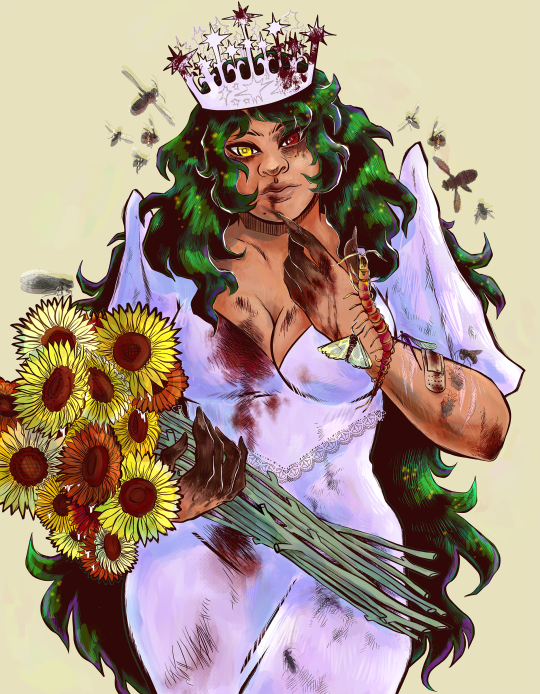
Mambabarang
2 notes
·
View notes
Text
I honestly wish to see more Filipino creatures in media. Ya know how scary it is to see a woman's top half flying in the deepest of the night using its huge bat-like wings?
Or or or or hearing a bird on your roof go "tik tik tik tik tik" as it calls for a monster, alerting it that there's a sleeping pregnant woman inside the house?
HOLD UP THO I KNOW A FUNNY STORY
so these "aswang" or monsters actually live and thrive in provinces, especially back then when there was no electricity and people went to bed early.
back then when many people from the province are moving to bigger cities like Manila, the monster people moved too, thinking the more people the more prey they have.
BUT BUT BUT they were shocked to see that even at night the cities were bright and full of people! even the houses are lit. 😂 so they had to go back to the province
WIKIPEDIA MONSTER COMPILATION PAGES FOR PEOPLE
japanese creatures
greek creatures
creatures organised by type
creatures listed by letter
humanoid creatures
filipino creatures
chinese creatures
cryptids
‘fearsome critters’
angels
beings referred to as fairies
creatures that pretend to be human
a page on therianthropic creatures
shapeshifters
hybrid creatures
extraterrestrial creatures
deities
a page of mythology page links
a section of folklore page links
flying creatures
theological demons
fictional species lists
mythology related lists
legendary creature related lists
#aswang#filipino monsters#tiktik#manananggal#this was apparently a true story#my grandfather told me this#wait i want to share more of my grandfathers stories
189K notes
·
View notes
Text

tw // blood, body horror
“Honora…“
“Not now, Benito! We've just uncovered—-“
“No…look!”
🥀🐦⬛🧛🍂
Tropical gothic my beloved i am SO back 🩸 decided to make a fake book cover about filipino monster hunters solving mysteries together
#artists on tumblr#digital art#digital illustration#digital painting#oc#original characters#vampires#vampire hunter#filipino folklore#manananggal#aswang#filipino myths#character illustration#character art#tropical gothic#philippines#filipino aesthetic#vampire aesthetic#southeast asia#SEAsian art#monster art#supernatural#fantasy#historical fantasy#dark fantasy#aesthetic#nik's art
408 notes
·
View notes
Text

one of my longest-standing headcanons in all its glory, half-filipino rex! 🇵🇭 after so many years, it's still near and dear to my heart 💙❤️
bonus:

#yugioh#rex raptor#dinosaur ryuzaki#yugioh duel monsters#yugioh dm#ygo#ygo dm#yugioh fanart#headcanon#headcanon design#filipino#jollibee#digital art#fanart#weevil underwood#insector haga#<- yes he's there too
175 notes
·
View notes
Text

Garlic-lover
155 notes
·
View notes
Photo
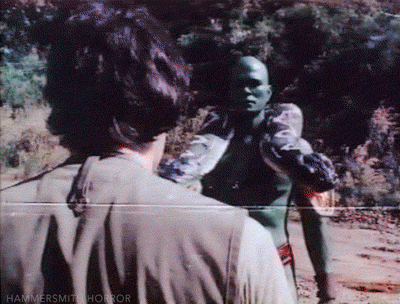
Zuma | 1985
#Zuma#Jun Raquiza#Jim Fernandez#Filipino horror#snake#monster movie#practical effects#horror#Hammersmith Horror#80s horror#hug#box your ears#bonk
1K notes
·
View notes
Text







It's the final countdown! 3 DAYS TO GO!
Please do check out our Kickstarter if you like sexy Filipino monsters 💜🙏🏾☺️ featuring Manananggal, Sarangay, Tikbalang, Sigbin, etc! All by Pinoy artists!
🇵🇭🔥🌟SUPPORT THE PINOY MONSTER LOVER ANTHOLOGY: AFTER DARK🌟🔥🇵🇭
#filipino comics#komiks#monster lover#filipino monsters#monster romance#monster boyfriend#monster girlfriend#queer comics
443 notes
·
View notes
Text
I was able to get the story from the woman who works for us who I will call Ka-J. and I had some interesting things come up from similar aswang stories I had read before. Here's some of the highlights of the story while I try to work on the transcript maybe for the next few days:
Aswangs could possess people and would often do so for selfish and even petty reasons. The possessed person was possessed for such a petty and miniscule reason that I'm honestly so perplexed. She possessed the woman because she... smelled good???? Like girl WHAT???? Just ask for her perfume brand or her laundry detergent brand holy shit
They fear holy items like crosses and rosaries. The possessed person from the story was cutting up rosaries and that's what primarily gave the aswang away.
The aswang could make the person's voice change. The possessed person was speaking at a strange tone extremely unfamiliar to her children.
The aswang may speak different languages, maybe unintelligible to the average person. I asked if it was in Latin or whatever stereotypical thing, but Ka-J said she could not determine that.
When the aswang was asked "Where did you come from? Above or below?", the aswang answered that she was "From below." implying that aswang do come from hell at least from this one incident.
The aswang exorcism didn't fully work the first time around so they had to do it twice. After the first instance, she was apparently worse.
They dislike calamansi which is something I've seen in some sources. This was done as an emergency way to freak out the aswang.
Folk healers could exorcise the aswang out of the person. Sometimes they may need the assistance of multiple healers. Ka-J. had told me that there were up to 7 to 8 healers during the final exorcism.
Some other interesting bits from the story that was told to me after or are things that seem just a little interesting to not add in but didn't fit the rest of the list:
The folk healers used an item she called "saway" (Note that Ka-J. is Bisaya but considering this takes place locally here, they probably call it a different name in the Tagalog region). She describes it as a brown (stick?) thing with a thorn attached. She says that there's a bit of gold on the item and when it pricks the aswang, the wound doesn't heal. I don't know what this item is, but it's similar to some stories I read where they would use certain tree branches or the buntot pagi (stingray tail) to injure the aswang.
The aswang was apprently a 50-year-old aswang woman. Very specific thing to have come from the exorcism. Besides that, she also gave her name and her "earth address" but Ka-J has forgotten what these were but it's probably pretty local.
One of the folk healers have a YouTube channel where he uploads the cases he handles. I had the displeasure of finding one of the videos and it is genuinely disturbing. It was just a woman crying but there was something eerie about it. I may not investigate further and I'm not going to link it here not only because of its disturbing nature, but this would essentially probably doxx me and I don't want these poor people's faces floating around because of my post.
I will try to get to actually transcribing + translating the short interview from the recording in maybe a couple of days. I think I may need to take a short break though since I feel a little uneasy after hearing and watching all that.
#filipinfodump#philippines#filipino#aswang#filipino folklore#filipino folk monsters#filipino monsters#filipino witchcraft#filipino aswang#folk healers#folk healing#folk monsters#witchcraft#exorcism#albularyo#possession tw#demon tw#mod maya
11 notes
·
View notes
Text
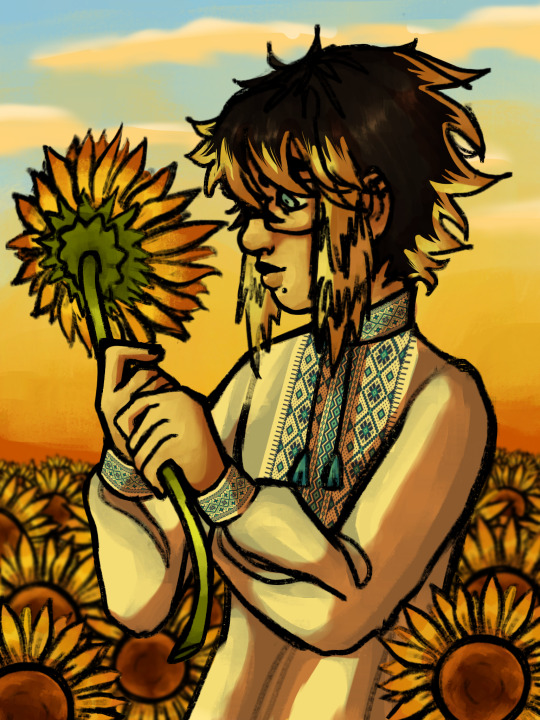
Jackson’s Scare-ritage🇺🇦
#monster high#jackson jekyll#my art#I’m not Ukrainian myself#but my version of Jackson is#I hope I did the vyshyvanka justice!#he’s also half filipino#not relevant to this piece but still
180 notes
·
View notes
Text
The Siyokoy [Filipino mythology]!

Aquatic humanoid creatures, usually with claws, scales and webbed appendages, live in lakes or rivers and drag unfortunate travelers under the water to drown them. To say that this story is a popular trope in folktales throughout the world would be about as big an understatement as saying that American chocolate chip cookies are popular in my apartment.
Almost every civilization has its own variety of aquatic humanoid monster, and that makes sense for two reasons: first, humans tend to drown when submerged for extended periods of time. A lot of people have drowned throughout human history, so it makes sense that many different myths arose about monsters who tried to drag their victims under the water. Second, these stories are often a variation of the classic ‘bogeyman’ tale: parents tell their children about a scary monster that would eat them (or bestow some other, presumably unpleasant fate upon them) to scare them away from bad behaviour.
A very common bogeyman tale is ‘if you venture too close to the river, a monster will come out and grab you’. This way, the child is dissuaded from playing near deep wells or rivers where it might fall in and drown (see reason 1 for more details on why this can happen).
In the Philippines, people believed in the Siyokoy (pronounced ‘Sho-koy’). These malicious monsters are dangerous creatures that lurk underwater. They are vaguely human-like in shape, but their head resembles that of a fish and their feet have webbed toes for swimming. The body of a Siyokoy is covered in fishy scales that are either green or brown, and they breathe through gills.

The Siyokoy eat human flesh, so they often hunt for fishermen. When a Siyokoy spots suitable prey, they grab their victim and drag them downward until they drown, before devouring them like I devour the aforementioned chocolate chip cookies.
Interestingly, there is some variety in the physical descriptions of these monsters. In some tales, they resemble classical mermaids (though male) with a fish-like lower body attached to the torso of a human. They are often said to have long tentacles to grab their victims. There are only male Siyokoy, because the monster is a counterpart of sorts to the Sirena, which are always female. Sirena are usually portrayed as human girls with a mermaid tail.
Sources: Bane, T., 2016, Encyclopedia of Beasts and Monsters in Myth, Legend and Folklore, McFarland, p. 294, 428 pp. De Las Caras, D. and Gagatiga, Z. C., 2011, Tales from the 7000 Isles: Filipino Folk Stories, Bloomsbury Publishing USA, p. 16, 204 pp. (image source 1: Gladys Domalaon, RPG corebook illustration for Secret Garden Games) (image source 2: Dread-Softly on Deviantart)
#Filipino mythology#aquatic creatures#humanoid creatures#monsters#mythology#mythical creatures#folklore#creatures
54 notes
·
View notes
Text

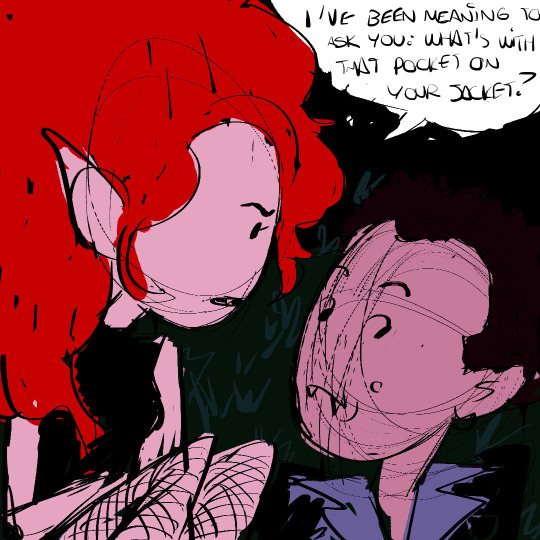
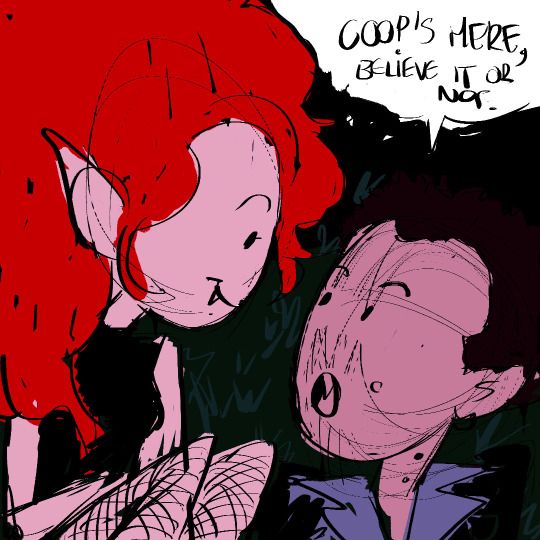
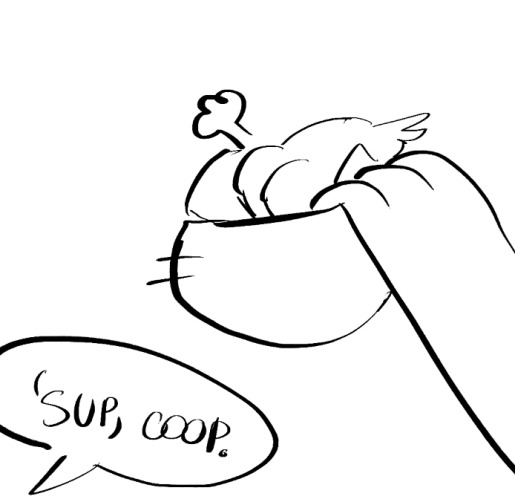
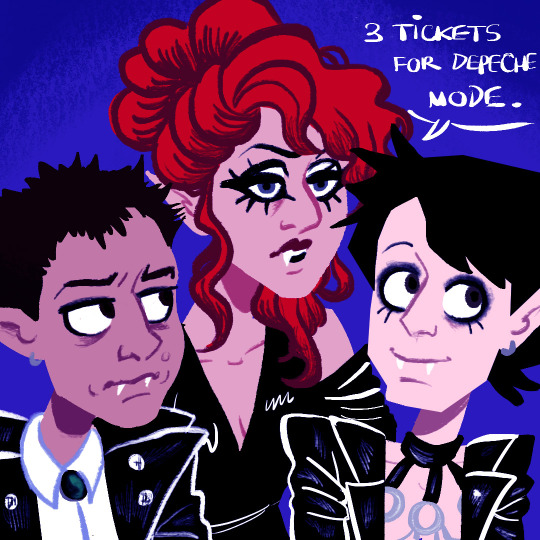
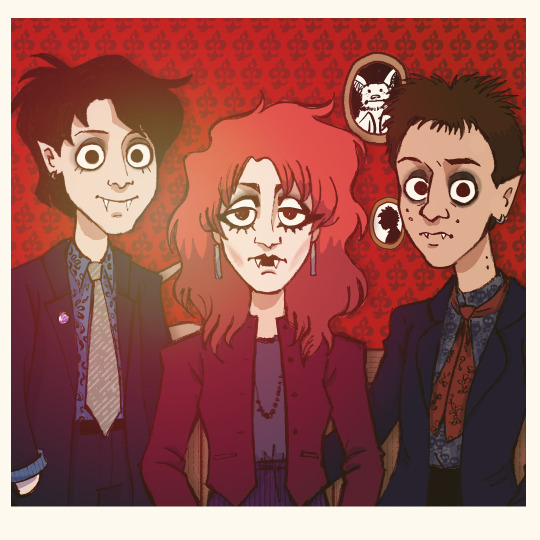

vampire diane, coop and albert art dump from my monster peaks/blue rose vampiric task force au! diane is heavily inspired by @laughingpinecone 's diane art so be sure to check her blog out!
#twin peaks#dale cooper#albert rosenfield#diane evans#art#my art#oli art tag#blue rose vampiric task force#monster peaks#twin peaks fanart#coop is a little brown bat and diane + albert are filipino bats if i remember correctly
22 notes
·
View notes
Text
gonna introduce u guys to some filipino monster heehee
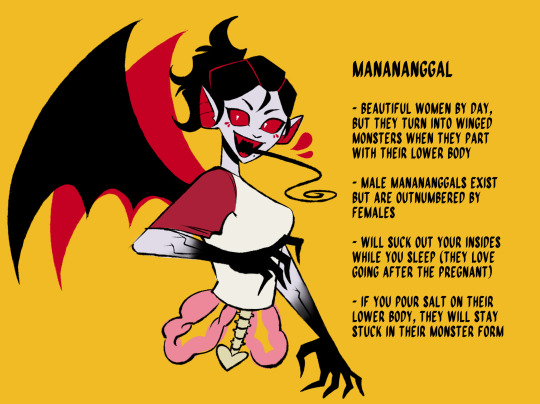
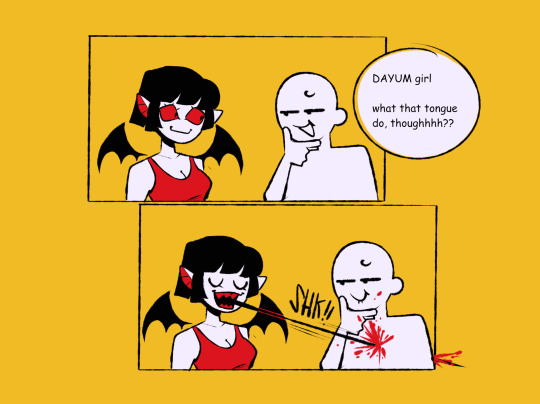
228 notes
·
View notes
Text
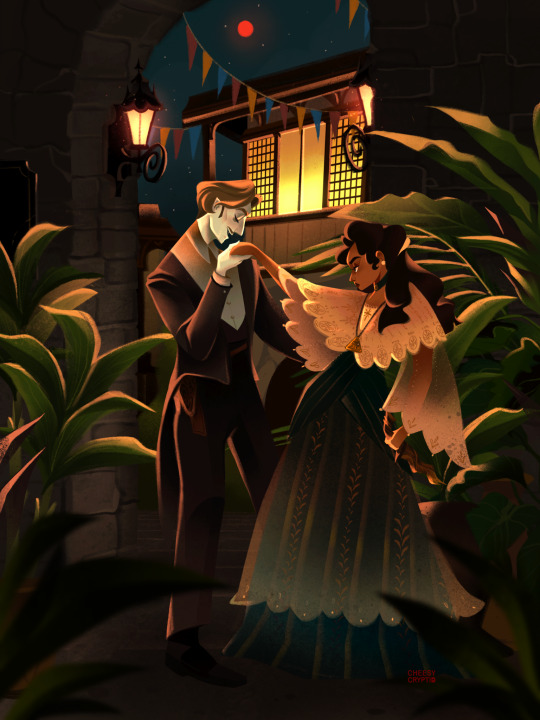
Vampires & Vampire Hunters but make it about during the late 1800s in the Philippines
#artists on tumblr#art on tumblr#oc#original characters#digital art#digital painting#digital illustration#vampire#vampire aesthetic#philippines#filipino aesthetic#1800s#American occupation#southeast asia#filipino#monster art#vampire hunter#vampire and vampire hunter#supernatural#fantasy#vampire and human#historical#historical fantasy#monster#dark fantasy#character illustration#character design#nik's art#aesthetic art
4K notes
·
View notes